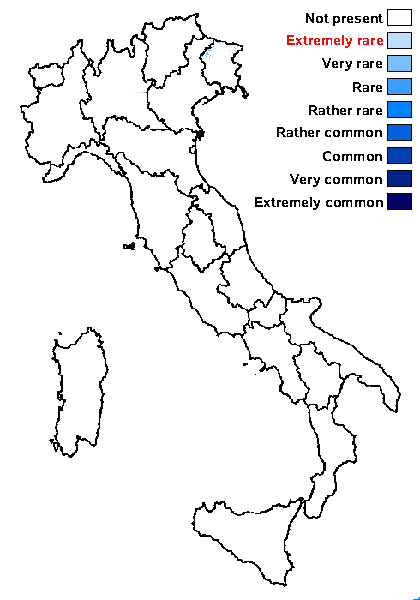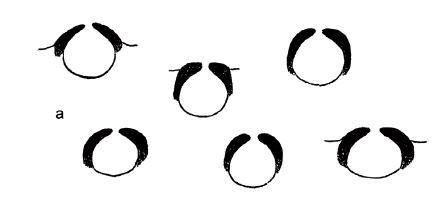Verrucaria finitima Breuss & F. Berger
Öst. Z. Pilzk., 21: 118, 2012.
Synonyms:
Distribution: N - Frl (TSB s.n.).
Description: Thallus crustose, episubstratic, rimose-areolate, dark brown to blackish brown, dull, c. 0.15-0.25 mm thick, more or less sharply delimited, without a clear prothallus, the areoles 0.3-0.7 mm wide, polygonal with acute angles, separated by thin fissures. Cortex well-developed, 10-25 μm thick, without an epinecral layer, of thin-walled cells; algal layer compact, 130-160 μm thick; medulla white, often blackening around the perithecia, but without a black basal layer. Perithecia black, rather sparse, c. 20/cm², 1-2(-3) per areole, ½-¾ immersed in thallus, the apical part projecting, conical to hemispherical, 0.3-0.45 mm across, with a broad ostiole, the ostiolar region slightly depressed. Involucrellum carbonized, adpressed to exciple, reaching at least 2/3 of the perithecium, 90-120 μm thick throughout; exciple 0.25-0.35 mm across, the wall colourless to brown, long remaining pale; hamathecium of sparingly branched, 20-30 μm long periphyses and periphysoids, interascal filaments absent; hymenial gel hemiamyloid, I+ red (I+ blue at very low concentrations of I), K/I + blue. Asci 8-spored, clavate, I-, fissitunicate, the wall thickened above, with an ocular chamber, dehiscent by extrusion of an endotunica to form a delicate rostrum, Verrucaria-type. Ascospores 1-celled, hyaline, broadly ellipsoid to subglobose, 10-14 x 7.5-10 μm. Pycnidia black, mostly at the margin of areoles, to 250 μm across, slightly projecting, the wall carbonized. Conidia bacilliform, straight to slightly curved, 6-8(-9) μm long, < 1 μm thick. Photobiont chlorococcoid. Spot tests: K-, C-, KC-, P-, UV-. Chemistry: without lichen substances.Note: a recently-described species, similar to V. poeltii, found near and above treeline in the Alps on hard, exposed limestone rocks with a long snow covering period. See also note on V. fischeri.
Growth form: Crustose
Substrata: rocks
Photobiont: green algae other than Trentepohlia
Reproductive strategy: mainly sexual
Commonnes-rarity: (info)
Alpine belt: very rare
Subalpine belt: very rare
Oromediterranean belt: absent
Montane belt: absent
Submediterranean belt: absent
Padanian area: absent
Humid submediterranean belt: absent
Humid mediterranean belt: absent
Dry mediterranean belt: absent

Predictive model
Growth form: Crustose
Substrata: rocks
Photobiont: green algae other than Trentepohlia
Reproductive strategy: mainly sexual
Commonnes-rarity: (info)
Alpine belt: very rare
Subalpine belt: very rare
Oromediterranean belt: absent
Montane belt: absent
Submediterranean belt: absent
Padanian area: absent
Humid submediterranean belt: absent
Humid mediterranean belt: absent
Dry mediterranean belt: absent

Predictive model
 INDEX FUNGORUM
INDEX FUNGORUM
 GBIF
GBIF
 DOLICHENS
DOLICHENS


